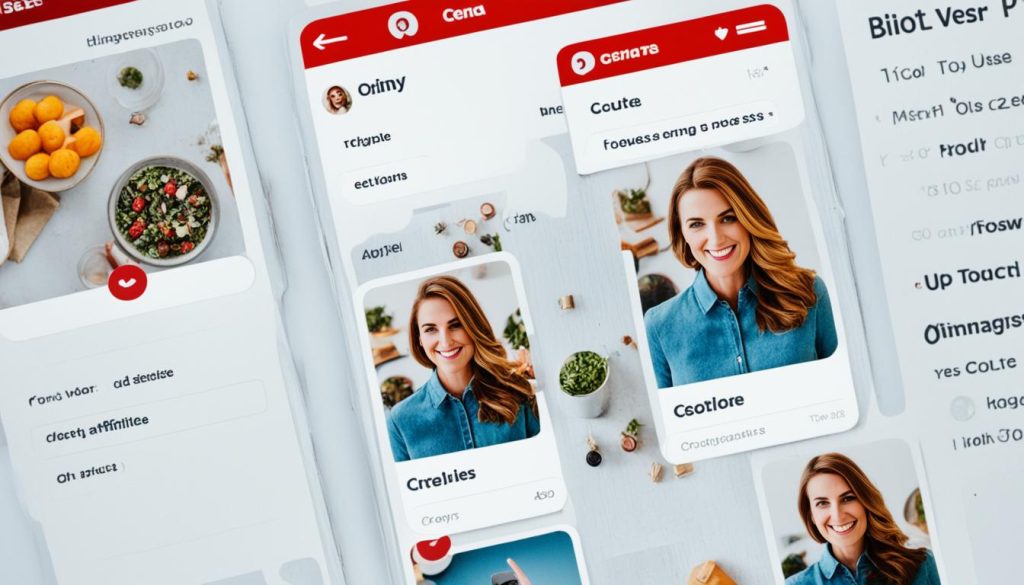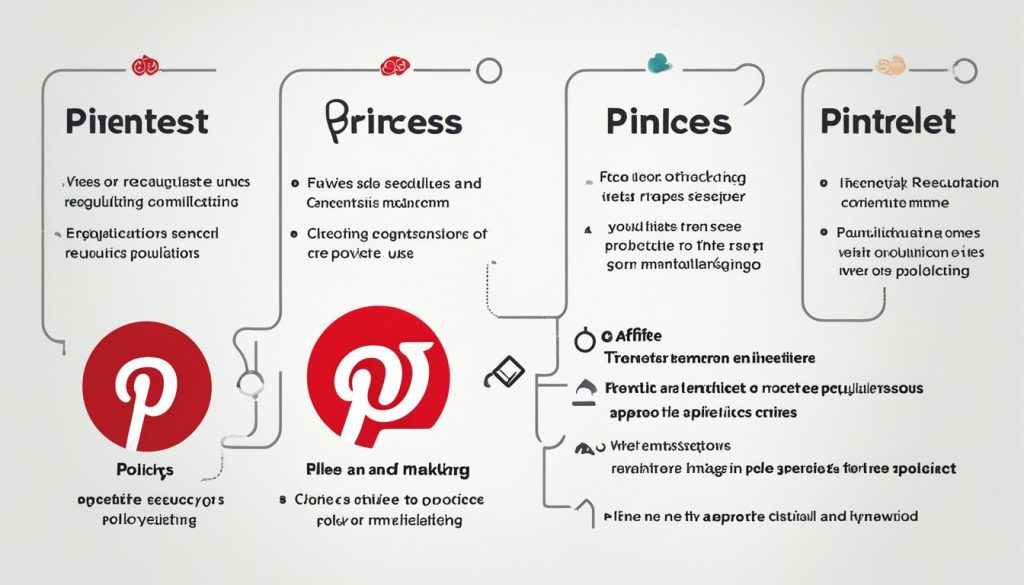Do you want to raise your affiliate marketing skills? Pinterest might be the answer you haven’t thought of yet. This platform is full of opportunities for affiliate marketers like you.
I’ll teach you how to use Pinterest to make more money in this detailed guide. Learn to set up your account, make your pins better, and track your success. With these tips, you can make your Pinterest work for you.
How to Use Pinterest for Affiliate Marketing
- Discover how Pinterest can be a game-changer for affiliate marketing success.
- Learn effective strategies to set up and optimize your Pinterest account for maximum visibility and engagement.
- Gain insights into selecting the right affiliate programs and diversifying your portfolio.
- Master the art of creating compelling pins that attract and convert your target audience.
- Understand how to build a strong Pinterest strategy, utilizing features like group boards and engaging with your followers.
Understanding Pinterest and Affiliate Marketing
Pinterest is a visual search engine where users discover inspiration and ideas. It has over 450 million active users each month. This makes it a great place for affiliate marketers to find a huge audience.
Affiliate marketing lets you earn money by promoting other people’s products. It’s beneficial for both sides: you make money and your audience gets valuable recommendations.
Pinterest is perfect for affiliate marketing because it’s visual and users are engaged. Unlike other platforms, Pinterest users want ideas, products, and solutions. They are ready to buy, which makes it easier to promote products they’ll love.
As an affiliate marketer, you can use great images and creative content to grab attention on Pinterest. Its visual interface lets you showcase products attractively. This increases your chances of getting people to engage and buy.
Pinterest helps your pins reach the right people with its smart algorithm. Using keywords in your pin descriptions and board titles makes your content easy to find. This boosts your visibility and helps more people discover your pins.
Overall, Pinterest is fantastic for affiliate marketing because it’s all about visuals, engagement, and making sales. Learning to use Pinterest effectively as an affiliate marketer opens up big opportunities for earnings.
Why Pinterest Works for Affiliate Marketing:
- Visual search engine attracting a vast audience
- Users with a buying mindset actively searching for ideas and products
- High engagement and conversion rates
- Ability to showcase products creatively
- Algorithm designed to surface relevant and high-quality content
- SEO features for optimizing visibility and discoverability
Getting Started with Pinterest Affiliate Marketing
To start affiliate marketing on Pinterest, first set up a business account or change your personal one. Make sure your profile stands out and learn how Pinterest works. This way, you’ll get more people to see your posts and boost your affiliate sales.
Craft an Appealing Profile
Making a great Pinterest profile is your first step. Your bio should be catchy, show what you know, and the good stuff you bring. Use the right keywords in your bio to come up in searches more often.
Pick a profile picture that shows what you’re about. It should be clear, look professional, and catch the eye. A good picture makes a strong impact and makes folks trust you more.
Select Relevant Boards
Choosing the right boards is key to reaching the people you want. Make boards that fit with what you’re selling. They should have great looking content. Also, name your boards with the right keywords to show up in searches.
Add pins to your boards that give good info and move your viewers. Mix in your own stuff with other top-notch pins in your area. This shows you know your stuff and keeps people interested.
Understand the Pinterest Algorithm
The Pinterest algorithm affects how many see your pins. Knowing how it works lets you make your content more popular. Pinterest loves new and top-quality posts. Keep adding new stuff and make pins that get people to save, click, and talk about them.
Being consistent on Pinterest is crucial. Regular pinning and being active helps you grow and reach more folks.


Remember, setting up your Pinterest for affiliate marketing is important. Get your account right, make a great profile, and understand Pinterest’s algorithm. Follow these tips to build a strong start on Pinterest.
Choosing the Right Affiliate Programs
Choosing the right affiliate programs is key to earning more as an affiliate marketer. Find programs that fit your niche and interest your audience. This guide will help you choose wisely and diversify your affiliate options.
Researching Affiliate Programs
First, research affiliate programs in your niche. Look for ones with good reputations, competitive commissions, and great affiliate support. Consider their track record, payment schedule, and how long they track sales (cookie duration).
Use online resources and forums to get opinions from other marketers. Choose programs known for timely payments and good affiliate terms. Make sure they have strong management systems and are easy to use.
Selecting Products to Promote
Next, choose the products you’ll promote. Keep these points in mind:
- Pick products that match your niche and audience. This increases the chance your promotions will convert to sales.
- Ensure the products are high-quality and relevant. Promoting great products helps gain your audience’s trust.
- Choose products that are in demand. Products with a strong presence in the market are easier to sell.
- Analyze the competition. Find products that offer something unique to stand out.
Diversifying Your Affiliate Portfolio
It’s good to focus on your niche, but diversifying helps you reach more people and reduce risks. Promoting different products and brands lets you explore new market segments and boost your earnings.
Collaborating with various affiliate programs allows you to offer a range of products. For instance, a health blog can promote fitness gear, supplements, and healthy recipes. This variety meets the different interests of your readers.
A varied affiliate portfolio boosts your income and reduces reliance on one program or product.
To earn more and provide value, research your affiliate options well. Regularly evaluate how your choices perform and make changes if needed. By improving your affiliate selection, you can succeed more as a marketer.
Creating Compelling Pins
To grab the attention on Pinterest, looks are key. Following best practices helps you make eye-catching pins that draw people in. These pins can lead to more clicks, saves, and interaction with your content.
Designing Visually Appealing Pins
Good looks attract Pinterest users. Here’s how to make your pins stand out:
- Use high-quality, eye-catching images that are relevant to your content.
- Choose a consistent color scheme or theme that reflects your brand or niche.
- Ensure your pins are easy to read by using clear fonts and legible text.
- Utilize white space effectively to enhance the overall aesthetic of your pins.
Writing Captivating Pin Descriptions
The description of a pin gives it context and can make it more discoverable. Here’s how to capture interest with your words:
- Include relevant keywords naturally within the pin description to improve searchability.
- Write concise and engaging descriptions that pique the interest of viewers.
- Focus on the benefits users can gain from clicking through to your content.
- Consider using call-to-action phrases to encourage users to take the desired action.
Leveraging Pinterest Features
Pinterest has features to make your pins look and work better. Here are some to use:
- Rich Pins: They show more info, like prices and availability, right on the pin.
- Story Pins: You can create a series of images or videos to tell a story and connect with viewers.
- Carousel Pins: These pins let you showcase several images or products in one pin, increasing engagement opportunities.
| Pinterest Feature | Description |
|---|---|
| Rich Pins | These pins provide additional details and information directly on the pin, such as product pricing and availability. |
| Story Pins | Create visual stories with multiple images or videos, engaging viewers in a unique format. |
| Carousel Pins | Feature multiple images or products within a single pin, offering more opportunities for interaction. |
Building a Strong Pinterest Strategy
To win in affiliate marketing on Pinterest, you need a smart plan. You should create a content calendar, use group boards, and talk to your followers. This helps you get seen more and increase your sales.
Establishing a Content Calendar
Setting up a content calendar is a key first step. It helps you decide when to post your pins for the best effect. Sharing great content regularly helps reach more people. Use scheduling tools or Pinterest’s feature to plan your posts well.
Utilizing Group Boards
Group boards are perfect for reaching more people and engaging on Pinterest. Joining and being active in boards related to your area can boost your content’s visibility. Always follow the board rules and engage with the community. This builds your reputation and helps grow your following.
Engaging with Your Audience
Connecting with your followers is crucial on Pinterest. Talk with them often and respond to their comments and messages quickly. Show you care by liking and sharing their content too. Great relationships with your audience lead to loyalty, more engagement, and better sales.
| Benefits of Building a Strong Pinterest Strategy |
|---|
| Increased visibility and reach |
| Higher engagement and interaction |
| Improved brand credibility and trust |
| Higher conversion rates and earnings |
To create a winning Pinterest strategy, focus on your content calendar, group boards, and audience interaction. Be consistent, real, and keep an eye on your results to improve. With hard work and smart moves, Pinterest can significantly boost your affiliate marketing.
Tracking and Analyzing Performance
After you’ve started using Pinterest for affiliate marketing, it’s key to watch and learn from your pins’ success. This helps you know what your audience loves. It guides you to tweak your posts for better results.
First, you must start Pinterest Analytics. Here’s the process:
Setting up Pinterest Analytics
- Go to your Pinterest business account and click on the “Analytics” tab.
- Verify your website using one of the available methods.
- Once verified, Pinterest Analytics will start tracking data for your Pins and website.
Setting up Pinterest Analytics helps you find out who your audience is. You also learn how well your content engages them.
Identifying Top-Performing Pins
With Pinterest Analytics, it’s easy to spot the pins that get the most attention and action. Knowing this helps you fine-tune your strategy. You can focus more on what your followers like.
Check the “Top Pins” tab in Pinterest Analytics. It shows which pins are attracting the most views, clicks, saves, and comments. Look closely at these pins’ content and design. They reveal what captures your audience’s interest.


Iterating and Optimizing
Found your best pins? Now improve your overall strategy this way:
- Look for shared qualities in your most successful pins. Do they focus on a certain subject or aesthetic that your audience loves?
- Use these insights to craft new pins that mirror those winning elements.
- Keep an eye on your Pinterest Analytics. It shows how well your new pins are doing. Adjust your approach based on what you find.
- Try out different pin styles, captions, and images. Discover what resonates the most with your followers and niche.
Optimizing your Pinterest efforts is a constant job. Always use Pinterest Analytics to guide your strategy updates. Enhancing your pins is key to achieving the best outcomes.
| Metric | Definition |
|---|---|
| Impressions | The number of times your pin appeared on Pinterest feeds, search results, or category pages. |
| Clicks | The number of clicks your pin received, showing how much users are interested. |
| Saves | Times users saved your pin, showing they plan to come back to it or act on it. |
| Conversions | The number of users who did something you wanted, like buy something or sign up, after seeing your pin. |
Refining your Pinterest strategy takes time and effort. Always track your results, adjust to new trends, and stay determined. By doing this, you’ll see long-term success in your affiliate marketing journey.
Monetizing Your Pinterest Traffic
Now that you’re driving traffic to your Pinterest and website, let’s talk money-making. A great way to do this is with affiliate links. Add these links to your pins and site. When someone buys through them, you get a commission.
Starting with affiliate links on Pinterest is easy. Here is what you need to do:
- Join an affiliate network or program that fits your content and audience. Amazon Associates, ShareASale, and Commission Junction are good places to start.
- Get your unique affiliate links for products or services you’re promoting. They track your referrals to ensure you’re paid for conversions.
- Create a pin and put your affiliate link in its description. Make the description engaging to encourage clicks and explore the product or service.
- You can also add affiliate links to your website or blog posts. This matches your Pinterest content, giving your audience more chances to buy.
Being open about your affiliate links is crucial. Tell your audience that you earn from their purchases through your links. This keeps their trust.
But there’s more you can do beyond affiliate links to make money:
- Sponsored Content: Partner with brands to create sponsored pins or blog posts. This brings in extra income while providing good content for your followers.
- Product Sales: Think about making your own products that match your niche. Use your Pinterest and website to sell these products directly.
To really make the most of your Pinterest traffic, mix these monetization strategies. Try different things, see what works best, and tweak your methods. This way, you’ll increase your earnings from Pinterest.
Staying Compliant with Pinterest’s Guidelines
It’s vital to understand Pinterest’s policies and be open about your affiliate marks. That way, you maintain trust with your viewers. By knowing the rules and being open about your affiliate links, you stay in line with Pinterest’s requirements.
Understanding Pinterest’s Policies
Pinterest sets rules to stop spam, false info, and bad behavior. Reviewing and following these guidelines is necessary to avoid trouble. This means no penalties or losing your account.
Important rules cover:
- Prohibited content: Pinterest bans content like illegal items, adult stuff, and harmful false info.
- Personal data protection: It’s key to respect privacy. Don’t share or gather personal info without permission.
- Intellectual property rights: Make sure your pins don’t break copyright or trademark laws. Use content rightfully yours or properly licensed.
Maintaining Transparency
When using affiliate links on Pinterest, being clear is crucial. It builds trust with people and follows ad and disclosure laws. Transparency is a must.
To stay transparent, consider:
- Disclosure statements: Clearly say in your pins or descriptions that you might earn from affiliate links.
- Honest recommendations: Only suggest products or services you truly believe in. Stay away from false or over-the-top claims.
- Transparency in pin descriptions: In the description, state if you’re affiliated with a brand or product. This helps viewers make informed choices.
By knowing Pinterest’s rules and being transparent, you create a reliable image on the platform. This way, you engage meaningfully with your audience.


| Pinterest Policy | Summary |
|---|---|
| Prohibited content | Categories of content not allowed on Pinterest |
| Personal data protection | Guidelines for handling user data responsibly |
| Intellectual property rights | Respecting copyright and trademark laws |
Conclusion
Pinterest is great for affiliate marketers to connect with audiences and boost sales. To succeed, use the strategies in this guide and keep up with the latest practices. It’s key to know the platform, make engaging content, and interact with your audience.
Pinterest’s visual nature offers a unique chance to present products in an attractive way. Optimize your profile and pins. Also, use Pinterest’s features to catch the eye of potential customers.
Pinterest: A Platform for Success
The Pinterest algorithm favors good, relevant content. So, you need to make pins that match your audience’s interests and keywords. Always check your Pinterest Analytics to see how you’re doing. This helps you know what works and how to improve.
Adding affiliate links to your pins is a smart move. But, make sure to follow Pinterest’s rules and be upfront about affiliate links.
Building a strong Pinterest presence helps you gain trust and succeed in affiliate marketing. Don’t forget to try different strategies and keep up with trends in Pinterest and affiliate marketing.
Start Pinning and Earning Today!
For both new and experienced affiliate marketers, Pinterest is full of chances to find new customers and make money. Use the advice from this guide to start your Pinterest affiliate marketing journey. Happy pinning, and here’s to your success!
Resources
Starting your journey to master Pinterest for affiliate marketing success means you’ll need good resources. These can give you guidance and more insights. Here are some useful resources, links, and references to help boost your Pinterest strategy:
Pinterest Help Center
For everything you need to know about using Pinterest for business, head to the official Pinterest Help Center. It offers articles and FAQs on various topics. Whether you’re setting up your account or looking to learn the latest features, the Help Center is a great place to start.
Pinterest Business Blog
The Pinterest Business Blog offers tons of tips, success stories, and case studies. These can inspire and guide your Pinterest affiliate marketing efforts. Keep up with the latest trends and insights directly from the Pinterest team.
Industry Blogs and Websites
There are many blogs and websites focused on affiliate and social media marketing, especially Pinterest. They offer detailed guides, expert interviews, and helpful tips. Exploring these can elevate your Pinterest marketing game.
Online Courses and Webinars
Think about taking online courses or joining webinars about Pinterest marketing and affiliate strategies. Many well-known platforms feature courses by industry experts. Their advice and experiences can be incredibly helpful.
Affiliate Marketing Communities and Forums
It’s a good idea to join affiliate marketing communities and forums. You can meet other marketers, ask questions, and share what you’ve learned. These places are great for learning from others and keeping up with the latest trends.
Recommended Books
Reading books about affiliate marketing, social media marketing, and using Pinterest can be really beneficial. They offer a deep dive into the industry, teach advanced techniques, and showcase real-life success stories. These can truly inspire your affiliate marketing journey.
Remember, success in Pinterest affiliate marketing comes with ongoing learning and adjusting. Dive into these resources and stay eager to learn. This way, you can keep improving your strategy and increase your earnings on Pinterest.
Glossary
To help you navigate the world of Pinterest and affiliate marketing, here is a glossary of key terms and definitions:
Affiliate Marketing: A strategy where people earn money by promoting others’ products or services.
Affiliate Program: A plan set by companies. It lets individuals get a commission for boosting sales or leads to their offerings.
Pinterest: It’s a place online where users find and share ideas through images and videos.
Pin: An uploaded or saved image or video on Pinterest. It shows an idea, product, or service.
Pin Description: Text with a pin giving more details. It explains what the shared content is about.
Rich Pins: Pins with extra info like product details or article titles. This info comes straight from the original site.
Story Pins: Pins for sharing content that gets people involved. Like tutorials or behind-the-scenes peeks.
Carousel Pins: Pins with several images or videos. Users can look through them for a better experience.
Group Boards: Boards on Pinterest for lots of users to add pins on a certain theme.
Pinterest Analytics: Pinterest offers this tool. It helps users see how their pins and accounts are doing.
This glossary makes it easier to understand Pinterest and affiliate marketing terms. Now, you can use the platform better and succeed with smart strategies.


